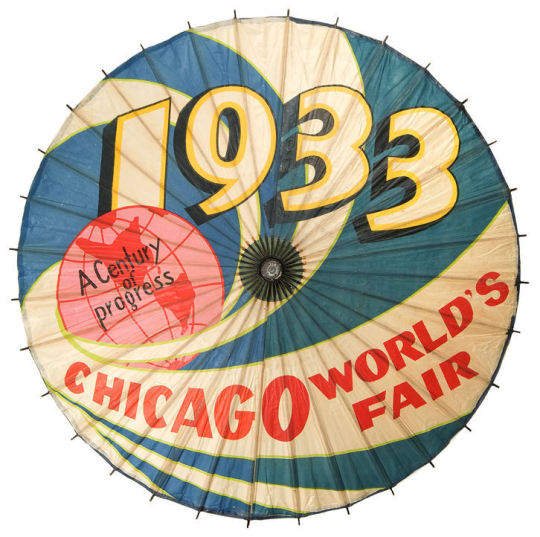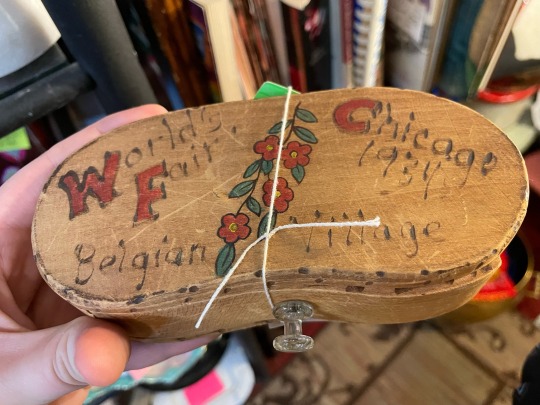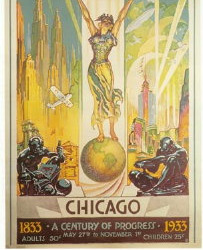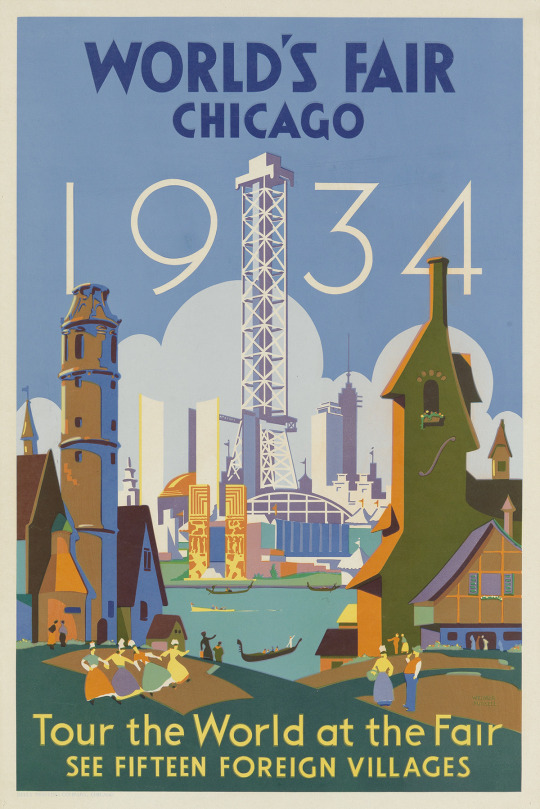#1933-1934 Century of Progress
Text
Deco Doings - April, 2024
Spring by William Welsh, 1930. Image from Pinterest.
Here are some wonderful Art Deco events to enjoy this April.
Bard Graduate Center
Sonia Delauney: Living Art (In Person Exhibit)
February 23, 2024 – July 7, 2024, 18 West 86th Street, New York, NY
Center Hours: Tuesday: 11:00 AM – 5:00 PM; Wednesday: 11:00 AM – 8:00 PM; Thursday – Sunday: 11:00 AM – 5:00 PM
Box, 1913. Oil on wood. 20…

View On WordPress
#1933-1934 Century of Progress#42nd Street#Art Deco Preservation Ball#Art Deco Society of California#Art Deco Society of Los Angeles#Art Deco Society of New York#Astaire & Rogers#Cecil Beaton#Century of Progress Homes#Chicago Art Deco Society#Cocktails in Historic Places#Detroit Area Art Deco Society#New York Adventure Club#Temple Emanu-el#The Grasshopper
1 note
·
View note
Text

Souvenir parasol from the Chicago World's Fair, 1933-'34.
#1930s#1933#1934#art deco#whirling planet#A Century of Progress#1933 World's Fair#1934 World's Fair#Chicago World's Fair#Chicago#Lake Michigan#parasol#modern#vintage#souvenir#ephemera
43 notes
·
View notes
Photo

A Native American demonstrates archery at the Century of Progress International Exposition, the world's fair held in Chicago during the summers of 1933 and 1934. © Century of Progress Records
#1933#1934#1930s#30s#A Century of Progress#Century of Progress#Chicago#Illinois#archery#World's Fair#~
124 notes
·
View notes
Text



Souvenir Box from the Belgian Village, 1934
I almost overlooked this one until my partner pointed it out to me. This claims to be from the 1933 World's Fair - also known as the Century of Progress International Exposition . Apart from a dysentery outbreak and the the ongoing depression associated with the Great Depression, the Rainbow City they built was a cheerful future outlook in an otherwise bleak time.



#chicago#1933#1934#belgian village#belgian#souvenir#map#century of progress#world's fair#world fair#chicago world's fair#history#box#vintage
5 notes
·
View notes
Text

Relief Panels from the Agricultural Pavilion at the Century of Progress World’s Fair in Chicago, Illinois, USA, 1933-1934
24” (63.5mm) wide x 84” (213.36mm) high
#art deco#art deco design#art deco architecture#art deco style#chicago world's fair#chicago#illinois
240 notes
·
View notes
Note
Favorite non-engine exhibit at the IRM?
I'mma give you a runner-up too because I'm not sure most people know about it.
Inside some of the cars in Display Yard 5, there is the Railroad China Collection and other assorted ephemera.


There's a number of things in there actually, but they've got a large collection of servingware used on various trains and the first time we were there, we were given a very personalized tour from a guy named Ken. Ken was quite opinionated (and correct) about how train stuff should be displayed and explained to normal people. Suffice to say, he understands the value of the story. We're hoping to see Ken again sometime.
Obviously I'm very about the fluting on the Zephyr servingware (you know we love a cohesive theme), but the Santa Fe dishes are also quite cool and have a great design history to go along with them.
My favorite non-engine exhibit though is the Winton 201 prototype engine.

This is tucked in the back of Barn 9 and is particularly interesting because this is the prototype engine for the one used in the Pioneer Zephyr. Indeed, this one could have been placed in Pioneer if the guys at Winton didn't have the good sense to say no.
This engine (along with a matching twin) was displayed at the Century of Progress in 1933, where Ralph Budd saw them and promptly asked the Winton guys to sell them to him right out of the display.

They declined, for two reasons. 1. These two engines were currently prototypes and being stress tested at that very moment in their display. And 2., the display they were being tested on was powering the General Motors building. So they kinda needed to keep them around for the moment.
Budd settled for waiting for the non-prototype version and a year later, the Pioneer Zephyr and his new Winton engine joined these guys at the Century of Progress for the 1934 season.
So this is a very important piece of Zephyr history.
But the thing that really makes it my favorite non-engine exhibit at the IRM is that it's probably the best example of them getting a little... editorial with their signage.

HOW DID THIS PROTOTYPE END UP AT THE IRM?
Late in 1987, IRM got a call from the GM Warehouse manager in Willow Run, Michigan. This facility stored all of GM's experimental, prototype, and test models. The person at GM indicated he was planning to retire, and his superiors asked him to find appropriate homes for some of GM's stored treasures before he left. Somehow, he had heard of the IRM and wanted to know if we were interested in a steam car? IRM was intrigued and ask for a picture. It turned out to be a 1969 Pontiac with an experimental steam generator under its big hood. IRM said thanks, but it didn't meet our Museum's mission, which embraces steam, electric and diesel railroad equipment. The man never heard past "electric", and he offered us an electric car. Thinking this might be something more aligned with what we do, we asked for a picture. This one turned out to be another late 60's auto with batteries packed under the hood - their first electric hybrid. Again, IRM politely declined, and reiterated the actual scope of our collection. This time he heard "diesel", and offered us an old engine they had sitting around. We said, "YES, we'd love to have it." It was shipped shortly thereafter and arrived in early 1988. It was promptly put on display on the skid it arrived on.
This was truly the diesel that started it all for EMD. That it exists at all, is astounding, and a significant historical treasure hidden in plain view. (the second prototype has never turned up and is apparently lost to history.)
Very "per my last email".
#the future is still silver and black#illinois railway museum#dishes for the santa fe lifestyle#it has been brought to my attention#that my favorite non-engine exhibit at the irm#is an engine
7 notes
·
View notes
Text
A Century of Progress

Century of Progress International Exposition ticket, 1934
91 years ago this week, the Century of Progress International Exposition formally opened in Chicago. The theme was technological innovation and it ran until November 1933, only to be so popular that it opened again from May-October 1934. Exhibits displayed technology of the future, recreations of the past, and artistic accomplishments of the present (unfortunately, the racism and exoticization of the present were also found in some exhibits).

Toy Town Tavern, 1933
The John I. Monroe collection of exposition postcards contains over 900 postcards from the Century of Progress International Exposition, including an admission ticket, paintings of exhibit buildings, and even some depictions of the Sinclair Dinosaur Exhibit.

Sinclair Dinosaur Exhibit, 1933
Explore all of the Century of Progress International Exposition postcards
7 notes
·
View notes
Text


Century of Progress Chicago World's Fair by Weimer Pursell 1933
Source, source

Chicago World's Fair by Weimer Pursell 1934
Source
18 notes
·
View notes
Video
youtube
Vintage Burlesque, Sally Rand's Bubble Dance, Remixed w/ New Music
Here we present the star attraction of the 1933-34 Chicago Century of Progress World's Fair. In this clip we see her doing not her famous fan dance but the sensually art deco bubble dance. We have added some special effects to the original film and added an original soundtrack by Captain Zero & the Radioactive Lovers Born Hattie Helen Gould Beck dancer Sally Rand began her career as a chorus dancer at the tender age of thirteen in Kansas City. While still a teenager Sally ran away with a carnival drifting west to Hollywood and the movies. By then Hattie had changed her name to Billy Beck and she found steady if not spectacular work, including some time working in the stock company of the great director Cecil B. Deville who gave Hattie her more famous name. Sally's movie career ended with the advent of the talkies due to her lisp. She went back to dancing which was her first love anyway. A resourceful gal looking for steady work she combined this love for dance with the average man’s desire to behold the female form and began experimenting with various forms of tease dancing. In 1932 while working at the Paramount Club in Chicago Sally developed her fan dance that would bring her fame and fortune. She was to become the mistresses of appearing to be naked and her big splash came at Chicago's Century of Progress World's Fair held in 1933 -34. For her arrival at the gates of the fair she recreated Lady Godiva's ride that along with her ensuing performance resulted with her being arrested four times in one day. At her trial the judge threw the charges out and in his decision said. "There is no harm and certainly no injury to public morals when the human body is exposed, some people probably would want to put pants on a horse. . . . When I go to the fair, I go to see the exhibits and perhaps to enjoy a little beer. As far as I'm concerned, all these charges are just a lot of old stuff to me. Case dismissed for want of equity." -- Superior Judge Joseph B. David - July 19, 1933 Even after the charges were dropped powerful forces sought to keep her from performing but her popularity was so great that they couldn't stop her. Wnen the fair reopened in 1934 she prsented the dance featured in this video the less risqué bubble dance. Sally did more road work for a few years before returning to southern California. There she briefly returned to the movies before moving to San Francisco. In 1939 she presented "Sally Rand's Nude Ranch" at the Golden Gate Exposition in San Francisco. It featured women wearing cowboy hats, gun belts and boots, and little more. Afterwards she took over The Great American Music Hall and started her own burlesque house and continued to perform for many years.
3 notes
·
View notes
Text
i love the novel release order of baccano! because it’s like, ok, we’re going to tell 3 stories in the 1930′s. the first one in 1930 is about how great being human is when you have people to share that experience with. the next two in 1931 are a bunch of people getting murdered on a train. you following? the third one in 1932 is a gut wrenching story about love and family in the darkest parts of new york’s underground crime network. now get this. the NEXT novel takes place in the 21st century in a remote european village and only 2 members of the cast are reoccurring from the previous 4 novels. got that? we’re back to the 1933 now. have another meaningful story about overcoming doubt and difficulty. ok it’s 1934 now everyone is in alcatraz and/or chicago. some of them are in alcatraz and chicago at the same time. imagine that. ok are you still with me? BAM. 1705. here’s backstory for this character we met for the first time in the last 3 volumes. BAM. 2002. TWO stories in 2002. why did they let a cult on these cruise ships? why did they let TWO cults on these cruise ships? i don’t know. we’re back to 1930 now but actually we’re not because we’re in 1710. now we’re in 1932 again. now we’re in 1711. now we get TWO BOOKS in 1935 but ah shit wait the plot hinges on these characters narita wrote for the anime-exclusive special novel so gotta publish that quickly, here’s another 1931 novel, ok now we can publish the last 3 novels in 1935. it’s been 6 years and 1935-e is still in progress.
1 note
·
View note
Text
### Top 25 Jewish Figures of the 21st Century
The 21st century has seen many Jewish individuals rise to prominence in various fields, including politics, science, arts, and business. Here are 25 influential Jewish figures, along with details of their contributions and achievements:
1. **Shimon Peres (1923-2016)**
- **Details:** Former President and Prime Minister of Israel. Nobel Peace Prize laureate for his role in the Oslo Accords.
2. **Benjamin Netanyahu (1949-)**
- **Details:** Long-serving Prime Minister of Israel, influential in Israeli politics and international diplomacy.
3. **Ruth Bader Ginsburg (1933-2020)**
- **Details:** U.S. Supreme Court Justice known for her advocacy for gender equality and civil liberties.
4. **Steven Spielberg (1946-)**
- **Details:** Renowned filmmaker, known for directing iconic films like "Schindler's List" and "Jurassic Park." Also a philanthropist supporting Jewish causes.
5. **Mark Zuckerberg (1984-)**
- **Details:** Co-founder and CEO of Facebook, one of the most influential figures in technology and social media.
6. **Natalie Portman (1981-)**
- **Details:** Oscar-winning actress known for her roles in films like "Black Swan" and "V for Vendetta." Advocate for various social causes.
7. **Sergey Brin (1973-)**
- **Details:** Co-founder of Google, significantly impacting global information accessibility and technology.
8. **Jon Stewart (1962-)**
- **Details:** Comedian and former host of "The Daily Show," influential in political satire and commentary.
9. **Michael Bloomberg (1942-)**
- **Details:** Business magnate, former Mayor of New York City, and philanthropist supporting public health, education, and Jewish causes.
10. **Natan Sharansky (1948-)**
- **Details:** Human rights activist and former Soviet dissident. Former Chairman of the Jewish Agency for Israel.
11. **Gal Gadot (1985-)**
- **Details:** Actress known for her role as Wonder Woman, symbolizing strong female representation in media.
12. **Bob Dylan (1941-)**
- **Details:** Iconic musician and Nobel Prize laureate in Literature, influential in music and culture.
13. **Doron Almog (1951-)**
- **Details:** Retired IDF Major General, known for his work with special needs communities and social activism.
14. **Arianna Huffington (1950-)**
- **Details:** Co-founder of The Huffington Post, influential in media and journalism.
15. **Jerry Seinfeld (1954-)**
- **Details:** Comedian and actor known for his influential TV show "Seinfeld."
16. **Leonard Cohen (1934-2016)**
- **Details:** Legendary singer-songwriter and poet, known for his profound and influential body of work.
17. **Amos Oz (1939-2018)**
- **Details:** Renowned Israeli author and intellectual, advocate for peace and human rights.
18. **Noam Chomsky (1928-)**
- **Details:** Linguist, philosopher, and political activist, influential in the fields of linguistics and social criticism.
19. **Daniel Kahneman (1934-)**
- **Details:** Nobel Prize-winning psychologist known for his work in behavioral economics and decision-making.
20. **Alan Dershowitz (1938-)**
- **Details:** Prominent lawyer and legal scholar, known for his defense of civil liberties and high-profile cases.
21. **Barbra Streisand (1942-)**
- **Details:** Iconic singer, actress, and director, influential in entertainment and philanthropy.
22. **Henry Kissinger (1923-)**
- **Details:** Former U.S. Secretary of State, influential in international diplomacy and foreign policy.
23. **Elie Wiesel (1928-2016)**
- **Details:** Holocaust survivor, author, and Nobel Peace Prize laureate, known for his work in human rights and Holocaust remembrance.
24. **Itzhak Perlman (1945-)**
- **Details:** World-renowned violinist, influential in classical music and cultural exchange.
25. **Bernie Sanders (1941-)**
- **Details:** U.S. Senator known for his progressive policies and influence on American politics.
These individuals have made significant contributions to their respective fields, leaving a lasting impact on the world and reflecting the diversity and talent within the Jewish community.

0 notes
Photo

Shifting Political Landscapes and Cultural Progress
The Quiet Coup of 1934
On the night of May 19, 1934, officers from the Military Union and the middle-class party Zveno (“the Link”) seized the opportunity in a tense climate and executed a bloodless coup d’état. King Boris III endorsed the new government led by Kimon Georgiev, dissolving the National Assembly along with all political parties and public organizations. This marked a period later referred to by historians as the “Monarch-Fascist dictatorship.”
Consolidation of Royal Power (1938)
By the summer of 1938, a regime of undivided royal power prevailed in Bulgaria. King Boris III, well-regarded abroad and among the Bulgarian public, strengthened the country’s security. Bulgaria moved closer to achieving a peaceful revision of the Treaty of Neuilly, which imposed military limitations. Relations with neighboring countries, especially Yugoslavia, significantly improved. Economic and cultural growth accompanied this period.
Economic and Cultural Landscape
During the first half of the 20th century, Bulgaria remained primarily agrarian, and its agriculture felt the impact of the global economic depression (1929-1933). Industrial development was slow, with small enterprises in light industry dominating Sightseeing Turkey, focused on processing agricultural raw materials. Despite the crisis, there was notable growth in domestic and foreign trade over the two decades after the war. New private banks, often with foreign investments, emerged.
Government support bolstered railway transport, and in 1927, the foundations of national air transport were laid. Bulgaria’s educational system, culture, and arts reflected national issues and historical tendencies. The mass media, including Radio Sofia, experienced growth, while museums and libraries received intentional support from municipalities and the state. The early 1930s witnessed the creation of the first Bulgarian sound film. Architectural progress and translations of Bulgarian literary works into foreign languages contributed to the integration of Bulgarian culture into Europe’s cultural life.
In summary, the interwar years in Bulgaria saw political transformations, economic challenges, and cultural advancements. The nation navigated through shifting landscapes, shaping its identity and contributing to the broader European cultural tapestry.
0 notes
Photo

Shifting Political Landscapes and Cultural Progress
The Quiet Coup of 1934
On the night of May 19, 1934, officers from the Military Union and the middle-class party Zveno (“the Link”) seized the opportunity in a tense climate and executed a bloodless coup d’état. King Boris III endorsed the new government led by Kimon Georgiev, dissolving the National Assembly along with all political parties and public organizations. This marked a period later referred to by historians as the “Monarch-Fascist dictatorship.”
Consolidation of Royal Power (1938)
By the summer of 1938, a regime of undivided royal power prevailed in Bulgaria. King Boris III, well-regarded abroad and among the Bulgarian public, strengthened the country’s security. Bulgaria moved closer to achieving a peaceful revision of the Treaty of Neuilly, which imposed military limitations. Relations with neighboring countries, especially Yugoslavia, significantly improved. Economic and cultural growth accompanied this period.
Economic and Cultural Landscape
During the first half of the 20th century, Bulgaria remained primarily agrarian, and its agriculture felt the impact of the global economic depression (1929-1933). Industrial development was slow, with small enterprises in light industry dominating Sightseeing Turkey, focused on processing agricultural raw materials. Despite the crisis, there was notable growth in domestic and foreign trade over the two decades after the war. New private banks, often with foreign investments, emerged.
Government support bolstered railway transport, and in 1927, the foundations of national air transport were laid. Bulgaria’s educational system, culture, and arts reflected national issues and historical tendencies. The mass media, including Radio Sofia, experienced growth, while museums and libraries received intentional support from municipalities and the state. The early 1930s witnessed the creation of the first Bulgarian sound film. Architectural progress and translations of Bulgarian literary works into foreign languages contributed to the integration of Bulgarian culture into Europe’s cultural life.
In summary, the interwar years in Bulgaria saw political transformations, economic challenges, and cultural advancements. The nation navigated through shifting landscapes, shaping its identity and contributing to the broader European cultural tapestry.
0 notes
Photo

Shifting Political Landscapes and Cultural Progress
The Quiet Coup of 1934
On the night of May 19, 1934, officers from the Military Union and the middle-class party Zveno (“the Link”) seized the opportunity in a tense climate and executed a bloodless coup d’état. King Boris III endorsed the new government led by Kimon Georgiev, dissolving the National Assembly along with all political parties and public organizations. This marked a period later referred to by historians as the “Monarch-Fascist dictatorship.”
Consolidation of Royal Power (1938)
By the summer of 1938, a regime of undivided royal power prevailed in Bulgaria. King Boris III, well-regarded abroad and among the Bulgarian public, strengthened the country’s security. Bulgaria moved closer to achieving a peaceful revision of the Treaty of Neuilly, which imposed military limitations. Relations with neighboring countries, especially Yugoslavia, significantly improved. Economic and cultural growth accompanied this period.
Economic and Cultural Landscape
During the first half of the 20th century, Bulgaria remained primarily agrarian, and its agriculture felt the impact of the global economic depression (1929-1933). Industrial development was slow, with small enterprises in light industry dominating Sightseeing Turkey, focused on processing agricultural raw materials. Despite the crisis, there was notable growth in domestic and foreign trade over the two decades after the war. New private banks, often with foreign investments, emerged.
Government support bolstered railway transport, and in 1927, the foundations of national air transport were laid. Bulgaria’s educational system, culture, and arts reflected national issues and historical tendencies. The mass media, including Radio Sofia, experienced growth, while museums and libraries received intentional support from municipalities and the state. The early 1930s witnessed the creation of the first Bulgarian sound film. Architectural progress and translations of Bulgarian literary works into foreign languages contributed to the integration of Bulgarian culture into Europe’s cultural life.
In summary, the interwar years in Bulgaria saw political transformations, economic challenges, and cultural advancements. The nation navigated through shifting landscapes, shaping its identity and contributing to the broader European cultural tapestry.
0 notes
Photo

Shifting Political Landscapes and Cultural Progress
The Quiet Coup of 1934
On the night of May 19, 1934, officers from the Military Union and the middle-class party Zveno (“the Link”) seized the opportunity in a tense climate and executed a bloodless coup d’état. King Boris III endorsed the new government led by Kimon Georgiev, dissolving the National Assembly along with all political parties and public organizations. This marked a period later referred to by historians as the “Monarch-Fascist dictatorship.”
Consolidation of Royal Power (1938)
By the summer of 1938, a regime of undivided royal power prevailed in Bulgaria. King Boris III, well-regarded abroad and among the Bulgarian public, strengthened the country’s security. Bulgaria moved closer to achieving a peaceful revision of the Treaty of Neuilly, which imposed military limitations. Relations with neighboring countries, especially Yugoslavia, significantly improved. Economic and cultural growth accompanied this period.
Economic and Cultural Landscape
During the first half of the 20th century, Bulgaria remained primarily agrarian, and its agriculture felt the impact of the global economic depression (1929-1933). Industrial development was slow, with small enterprises in light industry dominating Sightseeing Turkey, focused on processing agricultural raw materials. Despite the crisis, there was notable growth in domestic and foreign trade over the two decades after the war. New private banks, often with foreign investments, emerged.
Government support bolstered railway transport, and in 1927, the foundations of national air transport were laid. Bulgaria’s educational system, culture, and arts reflected national issues and historical tendencies. The mass media, including Radio Sofia, experienced growth, while museums and libraries received intentional support from municipalities and the state. The early 1930s witnessed the creation of the first Bulgarian sound film. Architectural progress and translations of Bulgarian literary works into foreign languages contributed to the integration of Bulgarian culture into Europe’s cultural life.
In summary, the interwar years in Bulgaria saw political transformations, economic challenges, and cultural advancements. The nation navigated through shifting landscapes, shaping its identity and contributing to the broader European cultural tapestry.
0 notes
Text

Bas-relief entitled “Atomic Energy” at The Century of Progress, Chicago Worlds Fair, 1933, 1934.
Chicago, Illinois, USA
#art deco#art deco design#art deco architecture#art deco style#Chicago#Illinois#worlds fair#bas relief
150 notes
·
View notes